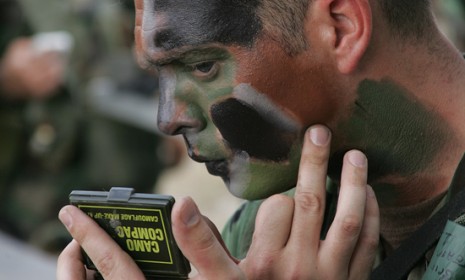Can makeup save U.S. soldiers' lives?
The Army reveals a heat-resistant face paint that can withstand 1,000-degree temperatures, giving soldiers crucial extra time to avoid severe burns from explosions

Soldiers often smear camouflage makeup on their faces before entering dangerous combat zones. But sometimes, the oil- or wax-based chemicals in face paint catch fire from a blast, which inflicts even more damage on the skin. That's why the Army is funding research for a new kind of high-tech combat makeup that, instead of putting a soldier at extra risk, can actually withstand a thermal blast as hot as 1,112 degrees Fahrenheit. A closer look at the Army's bomb-repellant makeup:
What does the face paint do?
"When a roadside bomb or other explosive device goes off, it hits everything nearby with an extreme blast of pressure" followed immediately by more than 1,000 degrees of skin-searing heat, says Colin Lecher at Popular Science, or about the same temperature as the burning tip of a cigarette. The Army's new face paint, presented this week at the American Chemical Society's meeting, not only functions as a heat shield, but is also waterproof and incorporates DEET, a type of insect repellant.
The Week
Escape your echo chamber. Get the facts behind the news, plus analysis from multiple perspectives.

Sign up for The Week's Free Newsletters
From our morning news briefing to a weekly Good News Newsletter, get the best of The Week delivered directly to your inbox.
From our morning news briefing to a weekly Good News Newsletter, get the best of The Week delivered directly to your inbox.
How effective is it at protecting skin?
Normally a bomb blast lasts a mere two seconds. Tests showed that the makeup protects "naked hands and feet for 15 seconds before mild, first degree burns appeared," says Molly Docherty at New Scientist. (Watch a demonstration below.) That gives a soldier valuable time to scramble away to safety.
How was the makeup made?
In order to create the skin cream, researchers turned to silicones rather than the "fatty substances in traditional face paint," says Megan Gannon at LiveScience. One problem: DEET bug repellant is highly flammable, yet it must compose 35 percent of all camouflage makeup, according to a military mandate. To solve the problem, scientists encapsulated DEET with a water-rich hydrogel, which prevented it from catching fire.
A free daily email with the biggest news stories of the day – and the best features from TheWeek.com
What's next?
The research team from the University of Southern Mississippi is putting together a clear, colorless version to be used by firefighters. They're also working on a fire-resistant formula to fireproof clothing and tents, says New Scientist's Docherty.
See for yourself:
Sources: Live Science, New Scientist, Popular Science


